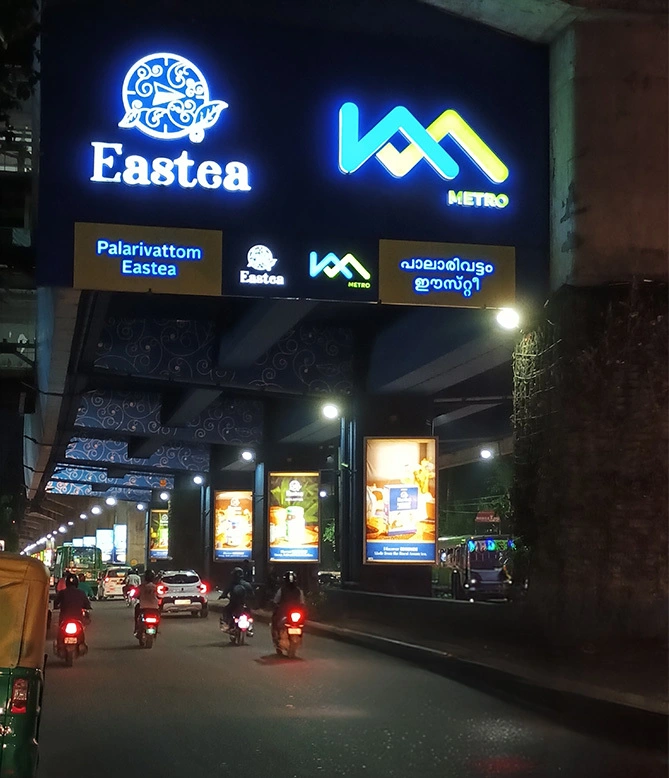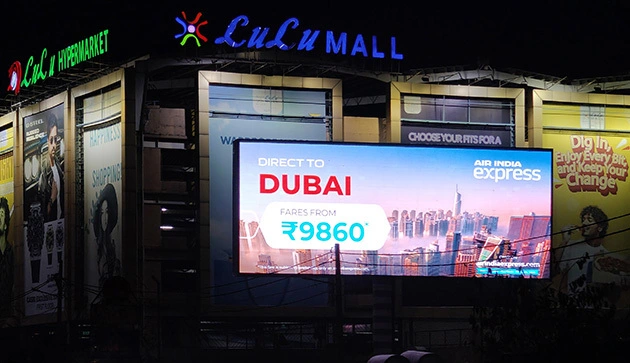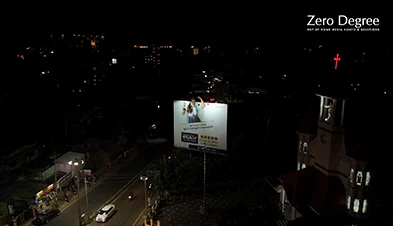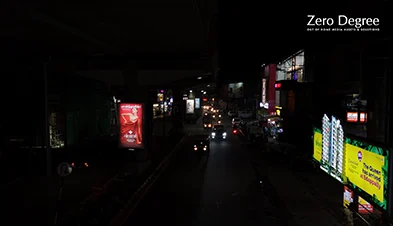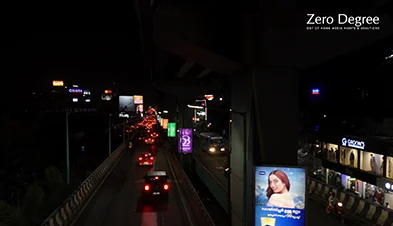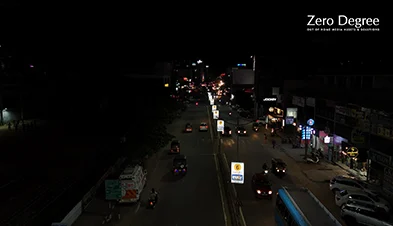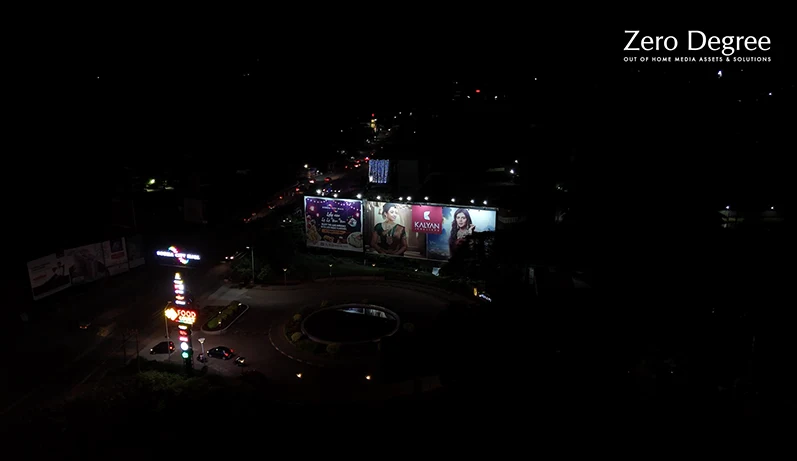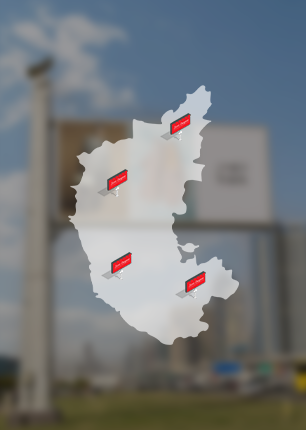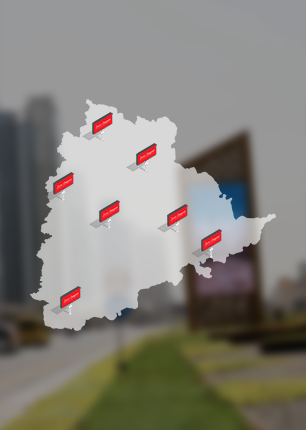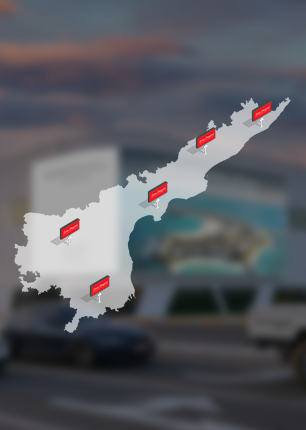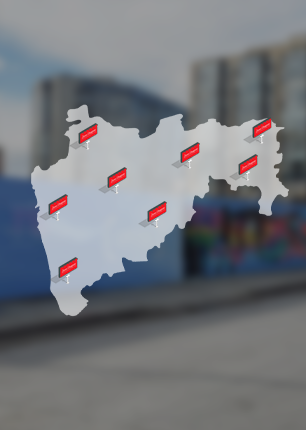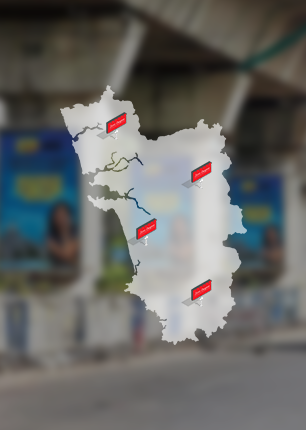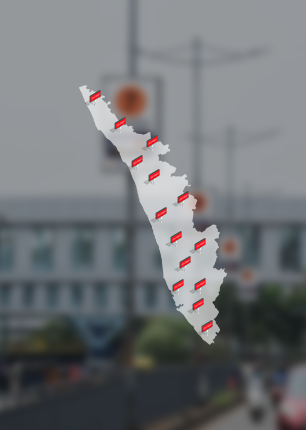
Outdoor LED Displays: Shaping the Next Era of Brand Visibility
In the modern business landscape, attaining maximum visibility for your brand is not just a goal; it is a necessity. This is where LED screen advertising
comes into play. Large and small businesses solely rely on them because of their ability to showcase messages vividly and advertise to a large audience in real-time. With the digital revolution shaping the new phase of advertising, outdoor LED displays are a game changer that boosts brand visibility and maximizes reach for your brand. In this article we will walk you through the possibilities of led digital screen advertising and its impact on the advertising industry.
What Are Outdoor LED Displays?
LED Displays are digital screens that use light-emitting diodes (LEDs) to show advertisements, announcements, and other attractive visual content that are usually placed in areas with a high volume of traffic to attract the attention of the public. In contrast to traditional billboards which present branding messages in a static format, outdoor advertising LED display screens are large-format, high-brightness digital screens which are created to work in open-air settings at any time. The light-emitting diodes incorporated in them are equipped with the capability to produce sharp images that do not lose their visibility even in direct sunlight, thus enabling videos or animations to be used as a source of the bright visuals to be displayed in the middle of the day. Therefore, outdoor LED advertising screens are the most impactful media that are extensively used by brands to attract the attention of the target audience through the provision of captivating and relevant content.
Advantages of LED Displays for Brands
There are a handful of advantages that come with choosing LED digital screen advertising for your brand. Here are a few benefits your brand can gain by adopting them.
High visibility : A striking feature that gives LED screen advertising an edge over traditional billboards is its exceptional visibility. With vibrant colors and dynamic content, it instantly captures the attention of passersby, making your message stand out even in busy surroundings. Day or night, outdoor advertising LED display screens remain highly noticeable, allowing your brand to reach a wider audience and maximize exposure.Dynamic content : LED billboards let you showcase dynamic content such as images, animations, videos and scrolling text. This flexibility gives the brands to craft engaging and interactive ads that capture attention and ensure interaction. This not only increases visibility but also strengthens brand identity.Real-time content updates : Another important aspect of LED screen advertising is that it can be operated in real-time. This allows brands to make alterations depending on the impact of the ongoing campaign as they can be easily programmed to update content in real-time, make necessary changes and optimize campaigns for maximum engagement.
How LED Displays Boost Brand Visibility
The dynamic visual impact that comes with LED digital screen advertising is something that traditional outdoor advertising techniques lack. The LED screens, widely known for their vibrant colors and bright output, display dynamic content in high resolution which makes it visible during day and night. Also, the dynamic nature of videos, animations and high-definition graphics effectively captures the attention of passersby, giving brands more reach than any static signage can achieve.
By consistently showcasing logos and brand messages, LED displays help brands to remain memorable to the public. This repetition builds recognition, familiarizes audiences with the brand, and ultimately helps brands achieve greater exposure. In addition, LED displays also ensure audience engagement by turning passive viewing into an immersive brand experience through touchscreens, motion sensors or QR codes. In addition, outdoor advertising led display screens also ensure audience engagement by turning passive viewing into an immersive brand experience through touchscreens, motion sensors or QR codes.
Applications in various industries
Advertising LED display screens are versatile and can be used in numerous settings.
Retail : Stores and retail outlets are the first to reap the benefits of LED screen advertising. By showcasing their products, offers and promotions on LED screens, they attract potential customers and encourage interaction within the shop.
Hospitality : Restaurants, hotels and cafes overwhelmingly utilize the power of LED digital screen advertising to display their menu, combos and offers in bright LED displays to create an exciting dinner experience to the guests. This urges customers to take action, try new cuisines and explore special offers, leading to a successful customer interaction.Corporate : Organizations across the globe display important company announcements through LED screen advertising to effectively communicate with employees, clients and stakeholders in real time.Outdoor advertising : By placing LED billboards in high-traffic zones, outdoor advertising agencies provide brands with unmatched exposure. Different types of outdoor advertising include mall branding, bus shelter advertising, pole kiosk and other attention grabbing out-of-home advertising formats that build brand visibility.
Future of LED Screen Advertising
With the rapid advancements in LED screen advertising, we are stepping into a new era of immersive engagement and intelligent brand storytelling. These developments are taking outdoor advertising to another level that static billboards and other outdoor advertising techniques can only imagine. Here are some interesting facts about the future of LED screen advertising.
Technological Advancements : Modern breakthroughs have fuelled theoutdoor advertising led display screen to evolve into various innovative forms. We can expect higher resolution screens for sharper and more immersive visuals along with LED screens that are flexible, curved or transparent in the years ahead.Data-Driven Advertising : We have already grown accustomed to living with AI, and it has become an integral part of our lives. Recently LED digital screen advertising have also started reaping the benefits of AI and analytics to design targeted campaigns to attract audiences based on location, time and demographics.Interactive Features : LED displays now include elements such as touchscreens and motion sensors to enhance the user experience. Recently, Augmented Reality(AR) has also been introduced into outdoor advertising LED display screens, setting a new trend in the ooh industry.
Final Word
Outdoor LED display trends are rapidly evolving, shaping the future of a truly immersive visual experience. Driven by technological advancements and creative innovation, the latest innovations in LED digital screen advertising can definitely change the face of your brand with its powerful impact. Also, with better quality and flexible displays, brands can guarantee greater visibility and stronger brand recall. With that said, the future of outdoor advertising is LED screen advertising, and a prominent company like Zero Degree delivers dynamic, interactive and visually striking advertising experiences. So leverage it now to boost your brand’s visibility. Because in the race for exposure, visibility is everything.

Top Benefits of Outdoor LED Advertising Screens for Businesses
As cities get smarter and streets more dynamic, capturing attention in public spaces has become more challenging than ever. Businesses operating in various sectors across the world are on the lookout for the latest innovations in advertising to give their brand message to the public and build unmatched visibility. The rise of outdoor LED screen advertising has emerged as the go-to option for organizations seeking impactful ways to promote their brands and has revolutionized the way brands engage with audiences like never before. Today, the streets and public spaces are filled with vibrant LED screens with captivating visuals that are likely to stay etched in the minds of passersby. In this article, we will shed light on some striking advantages of outdoor LED advertising. Let’s jump right in.
1. High Visibility & Attention-Grabbing
A key advantage of outdoor displays is their ability to to remain visible under any lighting conditions. The light-emitting diodes in them are equipped with the capability to produce sharp images that do not lose their visibility even in direct sunlight or at night. Many outdoor advertising LED display screens feature automatic brightness sensors that are capable of adjusting their light output according to the surrounding light conditions.
2. 24/7 Brand Exposure
LED displays operate day and night in contrast to static billboards or traditional advertising techniques that offer limited visibility mostly during daytime. As they are capable of displaying dynamic and interactive content they enable businesses to capture attention around the clock, avoiding the cost of additional lighting during the night.
3. Dynamic & Flexible Content
What gives LED screen advertising an edge over other methods is that you can change content instantly. In the digital era we live in, keeping the audience engaged is just as important as showcasing advertisements. Outdoor led advertising screens can effectively perform this task as they can be programmed in real-time to showcase dynamic and flexible content.
4. Cost-EffectivenessUnlike traditional billboards and posters that require additional cost for printing charges, LED screen advertising offers effective and a better experience on a single screen at low cost. Though the initial investment may be higher, it delivers greater ROI by enabling frequent content updates without extra printing costs. With the provision to upload content remotely, LED digital screen advertising also eliminates onsite maintenance, attracting businesses to invest in them.
5. Real-Time UpdatesCompanies no longer have to rely on static ads or spend time on repetitive printing. With just a few clicks, businesses can now upload and monitor the content on the advertising LED display screen without the hassle of manually replacing signage or printed ads. In addition, the dynamic scheduling feature allows marketers to set ad content on the display at designated times, weather conditions or for special occasions.
6. Stronger Brand Recall
People have a natural tendency to memorize things that are in motion. When the ads are curated in vibrant hues and combined with movement, the chances of engaging viewers and keeping them hooked to the content are higher. This gives brands the advantage of keeping their advertisements in people’s minds long after they’ve seen them. As a result, brands get stronger brand recall and prompts viewers to act after seeing the advertisement.
7. Eco-Friendly Advertising
Compared to conventional lighting, LED screens consume less energy. This quality is a unique advantage LED digital screen advertising provides. In fact, they are environmentally friendly and eliminate the need for paper and other physical materials. For brands seeking an eco-friendly advertising option, investing in outdoor LED digital screens can deliver a high ROI while remaining sustainable.
8. Multi-Content DisplayMultiple ads or messages can be displayed in rotation on a single LED panel, making it a very flexible marketing tool. This removes the necessity for deploying additional screens for promotional purposes of a variety of products or services. In addition, the ability to rotate content also allows businesses to plan campaigns for timely promotions, seasonal campaigns or targeted messaging for different audiences.
9. Limitless Creative FreedomThe printing and installation constraints that come with static billboards can be daunting. LED screen advertising offers more creative freedom for brands as it does not have any printing or installation limitations. The main advantage of campaigns that are tailored to certain areas is that the messages are delivered to people living in specific regions, and brands also have the opportunity to launch and evaluate several ad versions to determine which one is more receptive to the audience. As a result, they can employ diverse media such as videos, animations or live feeds to attract and involve their target market by developing fascinating and interactive content.
10. Boosted Engagement with Interactive TechIn today’s digital era, every platform features options to create engagement with users. The screens based on LED technology can exhibit numerous interactive features such as QR codes, motion sensors and other touch-sensitive interfaces that facilitate direct engagement with potential customers. Through such interactive elements, the LED screen advertising becomes more engaging and can serve as a game changer for brands.
Major Sectors Benefitting from Outdoor LED Advertising Screens
Several industries are reaping the benefits of outdoor LED advertising screens. Car dealerships display their newest models and special offers using LED screens that are visible at the showrooms' vicinity, whereas restaurants and beverages make use of the technology to entice new customers by advertising through vivid content displays. The healthcare sector, for instance, uses LED screens to communicate relevant health information, and the media companies on the other hand take advantage of the attractiveness of LED displays to advertise movies, events and shows, thus, ensuring audience engagement at the highest level. You can learn more about other industries that benefit from outdoor advertising screens in this article.
Final Thoughts
Outdoor LED screens have emerged as key tools for effective communication in today’s competitive digital landscape. With brands operating across various sectors battling for audience attention, the unmatched exposure that LED screen advertising offers them is invaluable. When the bright visuals and animated content comes along with interactive features, businesses can ensure maximum audience engagement and totally rely on them for stronger brand recall. With years of experience in LED display development, Zero degree offers outdoor display solutions engineered to perform reliably in real-world environments. By partnering with us, your brand can gain the reach and visibility it deserves.
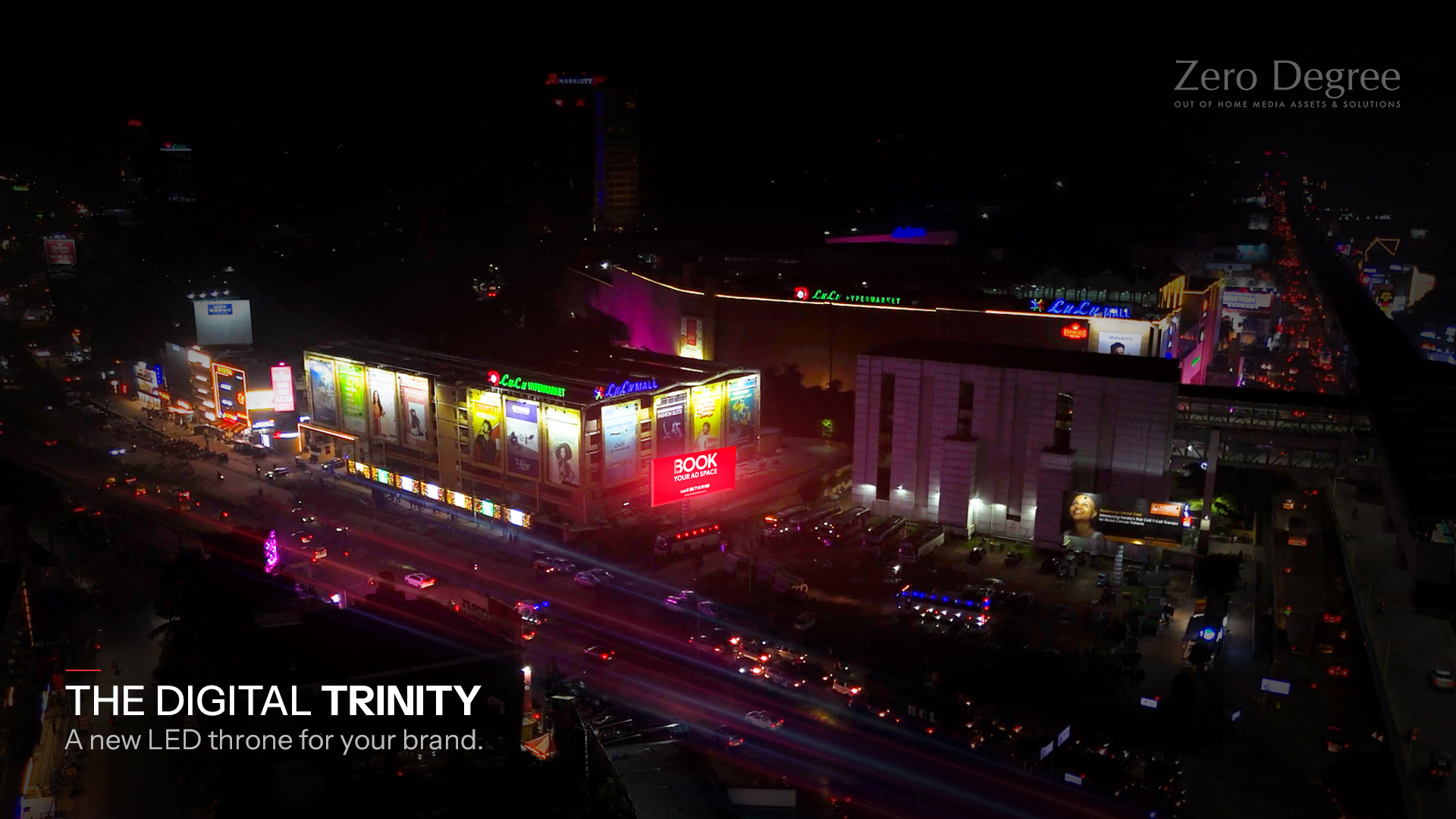
Zero Degree Illuminates Kochi: Three New Premium LED Screens Transform City Advertising
They’re here! Three new stars just lit up Kochi’s skyline. Zero Degree’s premium LED screens at Kundannoor (towards Alappuzha), Kundannoor (towards Vyttila) and Edappally are now live. We have opened up prime space for your brand to shine at all three locations. So, what does this mean for your brand?
We’ll tell you.
Prime Locations, Powerful Visibility
Strategically placed at the prime locations in Kochi, they offer maximum exposure and visibility for brands that are ready to take the spotlight. These are selected spots at various locations of the city where traffic and engagements are maximum. When brand messages are highlighted on them, your brand stands out in the cityscape. Built with advanced display technology, all three LED screens are designed with innovative features, capable of showcasing dynamic content in high definition with stunning visuals 24/7. In addition , these strategically positioned LED screens enable businesses to interact with the public all day long, marking a milestone in dynamic urban advertising. The high-traffic areas where they are installed amplify brand presence, capture attention in real time, and ensure that every impression contributes to stronger recognition and long-lasting citywide impact. Together, they set a new benchmark for outdoor digital advertising in Kochi.
Impact on Kochi’s Urban Experience
In a vibrant city like Kochi, getting your brand as the talk of the town can make all the difference. With its bright and enhanced visuals, the LED screens add energy and bring Kochi’s evolving urban landscape into a new dimension. Beyond the visual charm, these screens are useful communication tools that enable local companies to interact with communities in real time and reach audiences more successfully. By merging digital innovation with city spaces, they also stand at the heart of the city as a symbol of its rising urban identity. The incorporation of LED technology into the urban environment allows for dynamic displays that go beyond standard advertising and instead breathe life into the city. Through the use of these LED displays, both locals and tourists are offered an enriching experience of the development of Kochi, with brands having a unique way to showcase their brand messages as they continue to shape and evolve the cultural and commercial narratives of the city.
Zero Degree’s Vision & Commitment
With our extensive services that span across premium LED screens, strategic placements, and innovative OOH solutions, Zero Degree has been at the forefront of elevating Kerala’s out-of-home (OOH) advertising. Unlike traditional advertising techniques, the present day outdoor advertising campaigns feature dynamic and attractive content that contribute to higher brand recall compared to many other media channels. By leveraging cutting edge technologies, we ensure brands connect meaningfully with their audience. Moreover, combining technology with creativity through premium placement allows brands to provide measurable results from advertising as well. Each campaign helps establish stronger brand recall with the intended audience and thus enhances overall engagement throughout the state of Kerala.
Final Thoughts
Getting your brand message across the bustling city of Kochi is an advantage that you do not want to miss. With the installation of the brand new LED screens at three prime locations in the city, it is no more an opportunity. It is a powerful platform for brands to make a citywide impact like never before. Together, they mark a new chapter in the city’s advertising landscape and set a new stage for visual storytelling in the city. Partnering with Zero Degree ensures your brand takes center stage on Kochi’s busiest streets and leads the race for exposure. So make the most of it and amplify your brand’s reach. After all, in the battle for brand spotlight, visibility is everything.
MOST POPULAR ARTICLES
Technological Innovations in OOH Advertising
From Static to Dynamic: The Future of OOH with Technology-Driven Displays and Experiences. Join us as we explore the wave of innovations transforming the OOH landscape, highlighting how tech is reinvigorating life in public spaces and reshaping brand-audience relations.
Digital Out-of-Home (DOOH) Advertising
With that in mind, imagine walking through a busy city square adorned with digital screens instead of boring old billboards. Often used to show everything from weather updates to interactive social media feeds, these displays create a tapestry of content that engages passersby. That’s DOOH, a combination of tech and creativity that transforms static ads into active moments.
Programmatic Advertising
Upon this digital renaissance, programmatic advertising takes center stage as the maestro, conducting campaigns with both precision and efficiency. Through automation, advertisers are able to bid for digital billboard real estate in real time, ensuring that their messaging is hitting their target audience at exactly the right time. Not only does this maximize impact, but it provides flexibility, enabling campaigns to quickly pivot as circumstances change.
Artificial Intelligence
AI is the artisan in the OOH world, generating personalized and contextually relevant content. Imagine a digital kiosk that understands the time of day and adjusts advertising to feature coffee in the morning and meals in the evening. AI uses data like location, the weather, and audience demographics to prepare messages that touch a personal level and improve engagement and efficiency.
3D Anamorphic Displays
Taking a step further into the realm of innovation, 3D anamorphic displays dazzle the eyes by generating illusions that seem to fly off the screen. These holographic displays use sophisticated technology to create three-dimensional images that can be seen from certain angles, capturing the attention of passersby who marvel at lifelike images that seem to transcend the limits of their screens.
Augmented Reality (AR)
Augmented Reality translates to "real world," bridging the gap between physical and digital, and adding layers of digital content to the real world. All you do is point your smartphone at a bus shelter ad, and when the lens clicks, there’s the product demonstration right on your screen. Such an interactive layer engages attention not just from a visual point of view but also with immersive experiences that enhance consumer engagement.
Sustainability
While the industry marches ahead, there is a kneejerk balancing act between innovation and sustainability. Advertisers are adopting greener strategies, like using energy-efficient LED displays and procuring renewable energy for digital billboards. Such an initiative is not only eco-friendly but also appeals to the consumers who appreciate the green movement.
Case Study: MoonPie's Extraterrestrial Engagement
MoonPie recently ran a campaign specifically targeting aliens , a shining example of creative out-of-home advertising. They launched ads in the top alien hotspots for the U.S., using a made-up language and futuristic graphics to grab the attention of aliens and humans alike. This forward-thinking method not only created noise but also highlighted the endless potential of innovative OOH campaigns.
The Road Ahead: A Fusion of Creativity and Technology
Exciting OOH Advertising Future with Technology Creative Element: With everything from AI-powered personalization to virtual and augmented reality experiences, the industry is gearing up to deliver messages that people will not just see, but feel. With fast-paced audiences and an evolving digital landscape, the path forward will lie in combining technology and storytelling in a way that makes a connection.
Biometric and Facial Recognition Technology
The technology that is going to change the game is facial recognition. Some DOOH displays are equipped with biometric sensors that analyze age, gender, and even emotions to serve ultra-personalized ads. For example, a digital billboard in a shopping mall could recognize a young adult in front of it, and present them with promotions at fashionable clothing hookups, while showing parents disappear family-friendly content as they pass.
Hyperlocal and Geo-Targeted Advertising
Similarly, hyperlocal and geo-targeted advertising has gained its spot as a mighty weapon in the OOH arsenal. Brands can serve hyper-relevant ads based on a user’s exact location with the integration of GPS and mobile data. If a nearby potential customer walks by, for example, a fast-food restaurant can serve promotional content on to digital displays, wooing them in real time with the deal of the moment.
Voice-Activated OOH Advertising
The OOH industry is beginning to integrate voice technology, enabling audiences to interact with voice command billboards and kiosks. Interactive voice-activated ads can deliver more info, make product reservations, or even let users interact with brand experiences , simply by talking.
Blockchain for Transparency in OOH Advertising
Blockchain is solving transparency and ad fraud issues in the OOH advertising industry. Decentralized ledgers enable advertisers to monitor campaign impressions, authenticate the users who engage with the ads, and confirm that the ads are displayed to real people. This not only promotes trust between brands and advertisers, raising the credibility of the industry as a whole.
As OOH advertising evolves, it is important for brands and advertisers to embrace these innovations to remain relevant and engaging in an overactive digital world. This creative, interactive, and tech-heavy experience will likely continue to shape out-of-home advertising for future generations.
Zero Degree: Crafting Brand Journeys Through Kochi’s Metro Landscape
Kochi, the vibrant landscape of Kerala has always been on the move. The city, though has gone busy over the years still has an inherent hum in its streets that give out an energy of progress, which is all centred around the Kochi Metro. This common man’s commute has given a much needed elevation for the city as a symbol of modernity and connectivity. While the metro moves the city’s life and people, there is another force that has grown with a steadfast approach in shaping various brand perspectives and experiences and as an Out of Home ( OOH) advertising agency that has transformed Kochi’s urban space into a performing venue for brands. That’s Zero Degree!
The Power of Movement
Every day, thousands of commuters step into those clean, smart spaces of Kochi Metro. It’s not just a place of transit; it’s a place where people are open to a lot of discovery. Even if they’re rushing to work, or leisurely exploring the city, or heading back home, they pass through a network of stations that act as meeting points for ideas, experiences, and advertisements.
This is where Zero Degree steps in.
Recognizing modern commuters as more than just passengers, who are active participants in maintaining the vibe of the city, Zero Degree utilises this unique space of Kochi Metro to craft visual journeys that align with these decisive moments of movement. From large-format billboards that captivate the eye as the trains approach, to strategic digital screens that engage riders with dynamic content, Zero Degree turns Kochi metro into an active stage for global brands to narrate their captivating stories.
A Collaborative Experience
Zero Degree, with an exclusive partnership with Kochi Metro, represents the fusion of two powerful forces. They are in constant watch for the physical movement of people and the psychological movement of ideas. Their OOH campaigns are not largely static and they are designed to engage commuters as they move to literally encourage interactions to leave lasting impressions.
Each ad placement is meticulously planned to capture the attention of diverse audiences, from daily commuters to tourists exploring the city. Whether it’s a local brand wanting to speak to the city's heritage or a global brand bringing international flair, Zero Degree understands the pulse of Kochi and tailors each campaign to resonate with its people.
Take, for example, the metro stations in MG Road and Edapally, two of the busiest hubs in the network. Zero Degree strategically positions high-impact visuals in these areas, ensuring that brands become an integral part of the commuting experience. By tapping into the rhythm of daily life, they create advertising spaces that not only draw attention but also integrate seamlessly into the fabric of the city.
Turning Commutes Into Engagement Opportunities
The Kochi Metro is more than a transit system; it’s an evolving ecosystem of urban life. Zero Degree recognizes this and uses the metro not just as a medium, but as a touchpoint for meaningful engagement. Their ads don’t simply sit on the walls—they interact with passenger journeys, capturing their interest when they’re most open to new ideas. Whether it’s a digital display that delivers real-time promotions or a billboard that evokes curiosity, Zero Degrees creative mastery ensures that no message is lost in the crowd.
And it’s not just about visibility; it’s about contextual relevance. Commuters are more receptive to messages when they feel a sense of connection to their environment. By embedding brands into the flow of everyday life, Zero Degree makes every ad feel like a natural extension of the urban experience. Their campaigns become landmarks of the commute, helping brands in creating authentic connections with the people of Kochi.
A Metro of the Future: Shaping Tomorrow’s Brand Experiences
As Kochi Metro continues to expand, so does the opportunity for brands to embed themselves in the city’s evolving narrative. Zero Degree is already at the forefront of this transformation. They are pioneering innovative OOH solutions that go beyond traditional billboards and posters, incorporating cutting-edge technology such as interactive digital signage, QR code activations, and augmented reality experiences.
Imagine stepping off the metro and scanning a QR code that offers you an exclusive discount or guiding you to the nearest store or event. Or picture an augmented reality billboard that transforms the city skyline as you view it through your phone. These are not far-off concepts—they’re part of Zero Degrees vision for the future of OOH advertising in Kochi Metro.
With these innovations, Zero Degree continues to push the boundaries of what’s possible in urban advertising, turning Kochi Metro into a living, breathing marketplace for brands to engage with their audiences in fresh, exciting ways.
Shaping Kochi’s Brand Landscape—One Station at a Time
The partnership between Zero Degree and Kochi Metro is more than just a collaboration; it’s a shared vision for the future of branding in Kochi. Together, they are redefining how brands communicate in public spaces, turning Kochi’s metro stations and trains into immersive advertising environments that tell stories, spark conversations, and drive action.
For Kochi’s residents, this synergy transforms the daily commute into something more: a journey filled with inspiration, creativity, and discovery. And for brands, it’s an opportunity to be part of the city’s pulse, to move with the people, and to leave a lasting mark on the minds of consumers.
Zero Degree and Kochi Metro are not just moving people—they’re moving ideas, shaping perspectives, and crafting the future of urban advertising.
Ocean Outdoor Launches New Digital Screen in London’s Carnaby District
Ocean Outdoor Unveils The Screen on Carnaby: A Premier Advertising Display in London’s Iconic District
Ocean Outdoor has launched The Screen on Carnaby, a state-of-the-art advertising display situated in one of London’s most renowned retail and entertainment destinations. This impressive 6m x 3m landscape-format screen is strategically positioned above The London Palladium Wall of Fame, directly opposite the north entrance of Carnaby Street and in close proximity to the luxury retailer Liberty.
This latest digital installation complements Ocean Outdoor’s flagship advertising locations at Leicester Square and Piccadilly Circus, creating a high-visibility “golden triangle” for advertisers aiming to capture the attention of audiences in the heart of London’s Soho district.
Adidas Takes Center Stage with FW24 Originals Campaign
Adidas is the inaugural brand to utilize this new screen, launching its FW24 Originals campaign in collaboration with EssenceMediacom, which will run through October 31, 2024. This campaign highlights the screen's potential as a dynamic advertising platform in one of the city's busiest shopping areas.
Nick Shaw, Chief Revenue Officer at Ocean Outdoor, underscores the significance of this new addition, particularly as the holiday shopping season approaches: “The timing couldn’t be better for launching a new screen in the heart of London’s premium retail. The competition for consumer spending will be fierce this Christmas, and a platform for brands to engage audiences in Soho, Regent Street, and Oxford Circus will be a tremendous asset for advertisers.”
Carnaby: A Historic Hub of Fashion and Culture
Carnaby, steeped in a rich history of fashion and cultural movements since the 1950s, continues to be a major draw for both locals and tourists alike. The area boasts over 100 retail stores, 70 restaurants, and a variety of cultural events spread across its 14 streets, attracting an impressive average of 44 million visitors annually. The combination of heavy foot traffic and its reputation as a cultural hotspot makes the Carnaby location an ideal choice for brands looking to create a significant impact.
A Cutting-Edge Display Powered by Daktronics
The Screen on Carnaby is powered by Daktronics, a world leader in the design, engineering, and manufacturing of digital LED display technology and audio systems. This collaboration ensures that the screen delivers vibrant, high-quality visuals that capture the attention of passersby.
Revolutionizing Businesses with Interactive Digital Signage
Interactive digital signage is an ever-evolving trend that continues to incorporate new technologies, enabling businesses to engage with their target audiences in innovative ways. Here are some of the most recent news developments in this fast-moving field:
AI-Driven Personalization
AI is Revolutionising Digital SignageReal time content adaptability is made possible with AI based digital signage. The personalization of information also guarantees that viewers review applicable material, which elevates engagement and effectiveness. AI, for example, analyzes data to display targeted ads that appeal to niche audiences.
Advanced Touchscreen Technologies
The interface employed by touchscreen displays has advanced to provide more seamless and natural interaction. Haptic touch and gesture recognition are now the underlying tech of modern touch screens, letting users manipulate content by simply swiping or pinching. It improves the user experience and makes digital signage even more interactive and easier to navigate.
Integration of Augmented Reality (AR)
AR phenomenal giving better usage of the digital signage. AR-enabled signage superimposes digital data on the physical environment, with users able to interact with virtual objects in real-world locations, creating memorable brand engagement experiences.
Touchless Interactivity
In line with health and safety concerns, unobtrusive interactive solutions are being adopted. In the era of social distancing, gesture recognition and voice command are examples of technology that allow users to easily interact with digital signage solutions, offering a clean yet interactive experience.
Enhanced Data Analytics
Advanced analytics that measure user- interaction are embedded in the newer Digital Signage Solutions. By tracking how users interact with content, businesses can gather insights about consumers and use that information to better tailor content strategies that generate a greater return on investment.
Adoption of interactive digital signage cannot be overlooked in the world of innovation. Using Data, professionals are able to help in the advance progress of the technology and the capabilities of it always integrates at a more higher level.
ISE 2025: LG Electronics Debuts NextGen Digital Signage Solutions
LG Electronics introduces its next-generation digital signage solutions to meet the needs of various business sectors such as retail, corporate, education, transportation, and hospitality at Integrated Systems Europe, World renowned annual tech show (ISE) 2025. At this year’s exhibition, operating under the theme “Customized Solutions, Optimized Growth,” LG demonstrated innovative technologies designed to enrich customer experiences and address the changing needs of B2B customers.
AI Driven Kinetic LED Display
One of the highlights of LG's booth was the AI-driven Kinetic LED display, which was positioned right as attendees walked into LG's booth. The configuration is of 88 Conjoined LED panels measuring the overall size of 7,180 x 4,090 millimeters. The base structure rotates 360 degrees horizontally due to the inclusion of several cube-shaped, rotating modules within the structure, generating unique and captivating aesthetic demonstrations. When copious mirrors were integrated in the installation, its depth and moving elements came to life in a way to offer an experiential breakthrough making art and technology blend into a new era.
Innovations Born from Collaborations with Industry Leaders
LG highlighted its focus on partnership by teaming with major companies to showcase integrated solutions:
Logitech | Cisco | Crestron: Demonstrated corporate video advancements, emphasizing seamless integration with LGs display solutions.
Brightsign: A major player in the world of connected video signage, BrightSign showcased signage-specific content management solutions that enable the efficient and dynamic delivery of content.
Kokomo 24/7: Showcased school access management systems that would improve security and operational efficiency in educational environments.
Megapixel VR, Mo-Sys Engineering, and Brompton Technology: Partnered to highlight cutting-edge broadcast solutions that redefine visual narratives.
Improved LG MAGNIT Micro LED Displays
As the demand for ultra-high-definition screen solutions continues to increase, LG has unveiled enhancements to its award-winning LG MAGNIT Micro LED displays:
Facilitated Setup: An improved design enables installers to set the spacing between LED modules from the rear, easing the installation.
Improved Compatibility: Have been best adjusted with all kinds of content controllers bringing it possible different colors and better image quality.
Energy Efficiency: Standby power consumption is reduced by up to 98% from models of the past, encouraging the practice of sustainability and streamlining operational expenses.
Anti-Discoloration Technology High-Brightness Outdoor Signage
LG showcased high-brightness outdoor signage with proprietary Anti-Discoloration technology. This technology shields screens against yellowing from being exposed to the sun for extended periods of time, thereby enhancing their longevity and consistent performance. However, it was not until 2024 that this technology was corroborated by Underwriters Laboratories (UL), highlighting both its functionality and efficacy.
Complete solutions for retail environments
Inside the Retail Zone, LG showcased a range of solutions designed for the requirements of today’s retail:
Modular Kiosks: Kiosks that improve customer interaction and streamline operations that are flexible and easy to install.
Fire-Safe Digital Signage – Models US5P, UV5N and UP5Q have outer casings that are certified to fulfil international fire safety regulations (BS476 in the UK and EN13501-1 in EU), ensuring safety without losing out on performance.
LG Business Cloud for Unified Control of Displays
LG also introduced the LG Business Cloud, an online dashboard for commercial displays, which it uses to centralize management and operation of multiple displays from one device. In addition, businesses can remotely monitor device status, deploy content updates and manage device settings with this solution, which can improve efficiency and reduce on-site interventions when appliances are not working.

